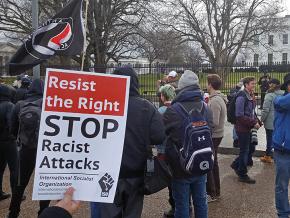Lessons from a far-right flop
reports on a counterprotest against a puny far-right rally held outside the White House — and what the event can tell anti-racist activists for the future.
A SMALL group of white supremacists held a pitiful rally in front of the White House on January 5.
The main organizer of the “Justice Isn’t Blind” rally, which drew five racists in all, was Jovi Val. Val is a right-wing activist who has attended events like the “Mother of All Rallies” in 2017 in Washington, D.C.
Most recently, he was a co-organizer of the far-right “Unite the Right 2” rally in defense of “white civil rights,” which was held on the one-year anniversary of the deadly demonstration in Charlottesville, Virginia, where anti-racist Heather Heyer was killed. A large anti-racist mobilization swamped the far right.
The Justice Isn’t Blind rally was organized in support of what Val calls the “true victims” of Charlottesville: the dozens of neo-Nazis and white supremacists arrested for committing acts of violence against anti-racist counterdemonstrators and others. This includes four members of the Rise Above Movement who are currently awaiting trial for their participation in the violence.

Another of the so-called “victims” is James Alex Fields — the neo-Nazi convicted of murdering Heyer and injuring several others, who drove his car into a crowd of anti-racist protesters.
The fact that far-right organizers think openly defending neo-Nazis and a convicted murderer will actually connect with the broader society is a sign of just how sick they have become.
THE FAR-right event on January 5 began around noon, with the five bigots walking up to the White House with an unfurled U.S. flag. They began by addressing their Internet livestream audience — since the only other people who showed up were counterprotesters, who began to gather and encircle the tiny racist rally.
Called by a local anti-racist group in Washington less than 24 hours before the rally was to take place, organizers had little time to build a broad response. Despite this, approximately two dozen anti-racist demonstrators turned out.
The overall strategy of the day seemed to be one of individual acts aimed at disrupting the far-right rally so that the bigots wouldn’t be able to speak. The reactionaries provoked anti-fascists activists with vile rhetoric, and police responded to the counterprotesters in an aggressive and violent manner.
Ultimately, four anti-fascist protesters were arrested and taken into police custody. One of the arrests took place after Val had tackled a counterprotester to the ground. In response, police reacted by arresting the anti-fascist protester.
Cops then formed a barricade around the bigots, putting themselves in between the two opposing sides and standing as a shield for the far right. It was clear by the police response whose “rights” they cared about protecting.
The fact that there was less than 24 hours to build for the counterdemonstration made it extremely difficult to build an action large enough to outmaneuver the fascists and police. Though their own turnout was tiny, the small numbers on our side allowed for the far right to claim they have support within society — plus this encouraged a focus on individual tactics instead of more effective collective actions.
Anti-fascist organizers should make sure we are providing multiple paths for people to participate in the movement against the far right.
In the aftermath of Charlottesville, mass mobilizations in Boston, Washington, D.C., and other cities showed how we can effectively outnumber and demoralize the fascists. The huge anti-racist turnout against the last demonstration Val organized in Washington on the anniversary of Charlottesville was humiliating for the far right.
It is essential that we do whatever possible to organize the widest response against the far right when they show up in our cities and build broad alliances that will allow us to begin to bring the vast majority of people who are anti-fascist, but have yet to join a protest, into the struggle.


